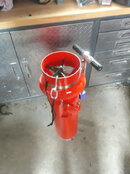Jon Nellis
Contributor
The tow cord is just one small part of a mechanical force vector system, that includes your hand, arm, back, fins, boltsnap and DPV. Where the tow cord attaches to the DPV is also relevant. Most are attached near the plane of thrust and symmetrical across the axis of thrust. Mounting the tow cord forward of the plane wound make it unstable and mounting too far behind it would make if very stable, but difficult to maneuver.
Assuming symmetrical tow cord attachment near the thrust plane and no user input, the (white) tow cord will naturally be pulled to intersect the thrust axis. The ring/boltsnap however, has friction with the tow cord and that friction changes with tension and angle between the tow cord legs, so the ring/boltsnap does not freely migrate to the thrust axis. The larger the included angle of the tow cord created by the boltsnap, the more tension there is on the tow cord between the attachment points (for those geometrically challenged Forces and Tensions in Ropes due to Angle ) and more force is placed on the DPV structure to react it. Running a short length of cord between the tow cord attachment points on the DPV and then running a straight cord (blue, in your example) back from it, is the worst combination of factors to unnecessarily increase stress. At a 120 degree tow cord angle, 40lbs of thrust would create 80lbs of (white) tow cord tension (40lb along the thrust axis and 40lbs squeezing the attachment point together) At 150 degree tow cord angle, 40 lbs of thrust would create 154lbs of tow cord tension. (40lb along the thrust axis and 114lbs squeezing the attachment point together). At 170 degree tow cord angle, 40 lbs of thrust would create 460lbs of tow cord tension. (40lb along the thrust axis and 420lbs squeezing the attachment point together). If you try shortening the white cord in your link that much, please have someone video it and post it here!
For reference, with a standard tow cord looped back to the divers waist with around a 30 degree angle, 40lbs of thrust only creates about 2lbs of "squeeze" force on the DPV structure.
Horizontal vs vertical orientation has been covered in those other threads listed above. Simple fact is that you will never be able to ride "hands free" (straight at a constant depth and no other contact with DPV) with a horizontal tow cord, but you can with a vertical tow cord, by taking advantage of the small amount of friction between the tow cord and bolt snap. Other than that, it's personal preference.
.
Assuming symmetrical tow cord attachment near the thrust plane and no user input, the (white) tow cord will naturally be pulled to intersect the thrust axis. The ring/boltsnap however, has friction with the tow cord and that friction changes with tension and angle between the tow cord legs, so the ring/boltsnap does not freely migrate to the thrust axis. The larger the included angle of the tow cord created by the boltsnap, the more tension there is on the tow cord between the attachment points (for those geometrically challenged Forces and Tensions in Ropes due to Angle ) and more force is placed on the DPV structure to react it. Running a short length of cord between the tow cord attachment points on the DPV and then running a straight cord (blue, in your example) back from it, is the worst combination of factors to unnecessarily increase stress. At a 120 degree tow cord angle, 40lbs of thrust would create 80lbs of (white) tow cord tension (40lb along the thrust axis and 40lbs squeezing the attachment point together) At 150 degree tow cord angle, 40 lbs of thrust would create 154lbs of tow cord tension. (40lb along the thrust axis and 114lbs squeezing the attachment point together). At 170 degree tow cord angle, 40 lbs of thrust would create 460lbs of tow cord tension. (40lb along the thrust axis and 420lbs squeezing the attachment point together). If you try shortening the white cord in your link that much, please have someone video it and post it here!
For reference, with a standard tow cord looped back to the divers waist with around a 30 degree angle, 40lbs of thrust only creates about 2lbs of "squeeze" force on the DPV structure.
Horizontal vs vertical orientation has been covered in those other threads listed above. Simple fact is that you will never be able to ride "hands free" (straight at a constant depth and no other contact with DPV) with a horizontal tow cord, but you can with a vertical tow cord, by taking advantage of the small amount of friction between the tow cord and bolt snap. Other than that, it's personal preference.
.




